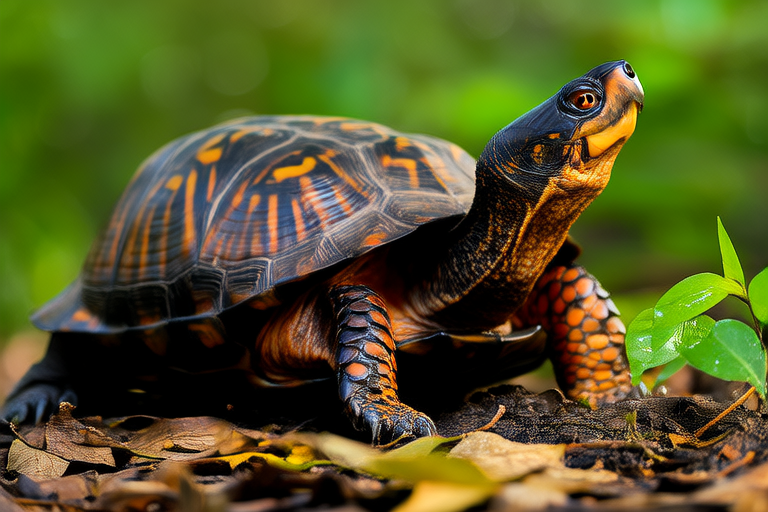Top 5 Fascinating Facts About the Enchanting Three-Striped Box Turtle
The three-striped box turtle (Amblyomma tricarinatum) is a small, terrestrial turtle native to parts of Central America. Despite its relatively modest size, this species boasts several unique characteristics that make it a fascinating subject for both amateur nature enthusiasts and seasoned herpetologists. From its distinctive appearance to its intriguing behaviors, the three-striped box turtle offers a wealth of interesting facts that highlight its ecological importance and charm.
1. A Distinctive Appearance with Camouflage Capabilities
One of the most striking features of the three-striped box turtle is its unique shell pattern. As its name suggests, this turtle has three yellow stripes running along its dark brown or black carapace. These stripes serve as an effective form of camouflage, helping the turtle blend into its natural environment. The stripes are particularly useful in dense undergrowth, where the turtle often seeks shelter. This adaptation is not just aesthetically pleasing but also crucial for survival, as it helps the turtle avoid detection by predators. Scientific studies have shown that these markings are less conspicuous when viewed from above, making it harder for aerial predators like birds to spot them.
2. Exceptional Self-Defense Mechanism
Like many other box turtles, the three-striped box turtle possesses a remarkable self-defense mechanism: it can completely withdraw its head, limbs, and tail into its shell. This behavior is facilitated by the hinge on the plastron, which allows the turtle to seal itself tightly within its protective armor. This ability not only shields the turtle from physical harm but also reduces water loss, which is particularly beneficial during periods of drought. In addition to this, the turtle’s hard, bony shell provides an effective barrier against many potential threats, including larger animals and harsh environmental conditions.
3. Habitat Preferences and Behavioral Adaptations
The three-striped box turtle thrives in humid, forested environments, preferring areas with dense vegetation and access to shallow bodies of water. These habitats provide ample opportunities for the turtle to find food, mates, and shelter. Its diet primarily consists of fruits, insects, and other small invertebrates, which it hunts during the day. Interestingly, the turtle is known to follow specific routes within its territory, often returning to the same feeding spots and resting places. This behavior suggests a level of cognitive mapping that aids in efficient resource utilization. Furthermore, the turtle is adept at digging burrows, which it uses for hibernation during colder months and as temporary shelters during hot weather.
4. Unique Reproductive Strategies
The reproductive strategies of the three-striped box turtle are as intriguing as its other behaviors. Females typically lay clutches of eggs in shallow nests they dig near water sources. The incubation period for these eggs is approximately two months, after which hatchlings emerge, fully independent. What makes this process particularly interesting is the temperature-dependent sex determination of the hatchlings. Warmer temperatures tend to produce more females, while cooler temperatures favor males. This phenomenon is believed to be an evolutionary adaptation that helps balance the sex ratio within the population. Additionally, the hatchlings’ early independence means they must fend for themselves almost immediately, developing survival skills from a young age.
5. Conservation Challenges and Efforts
The conservation status of the three-striped box turtle is a cause for concern. While it is currently listed as ‘Least Concern’ by the International Union for Conservation of Nature (IUCN), its populations face numerous threats, including habitat destruction, pollution, and illegal pet trade. Urbanization and deforestation have significantly reduced the availability of suitable habitats, forcing turtles to adapt to new environments or perish. Pollution, especially in aquatic ecosystems, poses additional risks by contaminating food sources and affecting water quality. Moreover, the illegal pet trade has contributed to declines in wild populations, as many individuals are captured and sold for commercial purposes.
Conservation efforts are underway to address these challenges. Organizations and governments are working together to protect critical habitats, enforce stricter regulations on wildlife trafficking, and raise public awareness about the importance of preserving turtle populations. Educational programs aimed at schools and communities help promote understanding and appreciation for these reptiles, fostering a sense of responsibility towards their protection.
Conclusion: Join the Effort to Protect Turtles
The three-striped box turtle is a remarkable creature with many unique attributes that make it a valuable member of its ecosystem. From its striking appearance to its adaptive behaviors, there is much to admire about this small but resilient turtle. However, the ongoing threats to its survival remind us of the urgent need for continued conservation efforts. By supporting local conservation initiatives and spreading awareness about the importance of protecting these species, we can contribute to ensuring the future of the three-striped box turtle and other endangered animals.
Whether you’re an avid nature lover or simply curious about the world around you, taking action to support turtle conservation can make a significant difference. Consider volunteering with local wildlife organizations, participating in educational workshops, or even adopting sustainable practices in your daily life. Every effort counts in the fight to preserve these enchanting creatures for generations to come.
